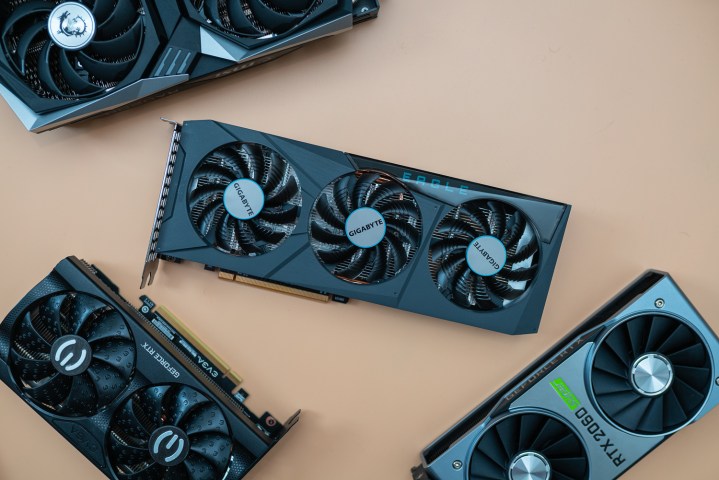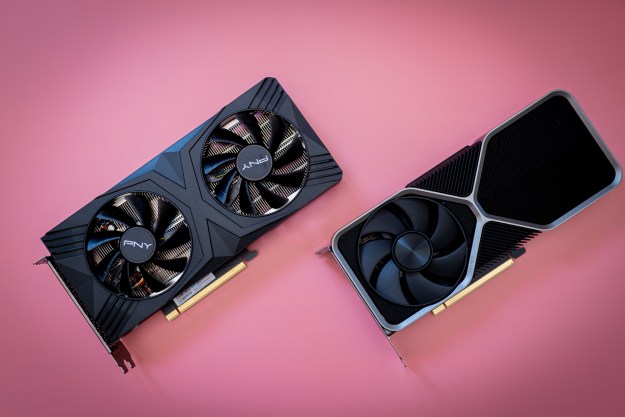As the GPU industry returns to normalcy, it seems the end of the GPU shortage has finally arrived, with a new Nvidia campaign highlighting the fact that stock levels for RTX 30-series graphics cards have been significantly boosted.
Anyone looking to equip their system with any RTX 30 board should no longer have a problem finding one to purchase, with Team Green’s Restocked & Reloaded initiative confirming that stock for all variants of the GeForce RTX 3000 range has been replenished and will reportedly remain in stock indefinitely moving forward.

GPU shortage is finally coming to an end
Alongside a general statement mentioning that “GeForce RTX 30 Series graphics cards are now available,” a quick look at Nvidia’s external retailer links associated with its GPUs does indeed show that these boards are now largely available at most online marketplaces.
For example, the Asus GeForce RTX 3080 TUF OC Gaming is now in stock at Overclockers, with its price dropping by almost $400 as well.
One of Nvidia’s partners, EVGA, also recently restocked certain RTX 30-series products such as the RTX 3080, which can be bought at prices that are much more affordable than some of the inflated costs that were widespread during the peak of the GPU shortage.
It therefore seems that the days of struggling to acquire an RTX 30-series video card are behind us. Due to the GPU shortage and the ensuing global price increases, popular graphics cards, particularly from both AMD and Nvidia, were extremely hard to find over the past two years.
During 2020 and throughout 2021, scalpers capitalized on the situation and charged customers prices that were 200% to 300% over the manufacturer’s suggested retail price (MSRP) for certain boards. Crypto miners were also looking to obtain these same GPUs because of their cryptocurrency mining abilities.
The result? Two groups that ultimately made it near to impossible for those looking to upgrade their PCs with an Nvidia or AMD-based video card. The shortage was exacerbated when scalpers and miners started relying on strategic methods to buy a GPU such as automated bot systems.
As such, unless you paid a small fortune to third-party marketplace resellers, waited in line for countless hours, or masterminded a criminal heist, you wouldn’t be able to find a decent GPU.
The shortage even affected last-gen graphics cards, with Nvidia Turing boards in particular seeing their retail prices soaring.
Still, by all accounts, the end of the GPU shortage appears to have, at long last, materialized.

Prices for GPUs continue to approach their MSRP
Alongside Nvidia’s new campaign, GPU prices are continuing to drop, according to 3DCenter’s latest report analyzing the manufacturer’s suggested retail prices of boards.
From March 27 to April 17, Nvidia GeForce RTX 30 and AMD Radeon RX 6000 graphics cards cost 19% and 12% over their MSRPs, respectively. Both ranges were priced 25% over their MSRPs during the latter stages of March.
The chart confirms that availability for Nvidia and AMD GPUs is now at its highest level since January 2021.
The aforementioned figures cover the GPU market in Germany, but we’ve seen similar price drops in other key regions, including the U.S., U.K., and Australia.
As Tom’s Hardware notes, the rate at which prices for Nvidia GPUs are declining is slower than the drops for AMD cards. To this end, 3DCenter suggests “the time of rapid price reductions is now over.”
Tom’s also aptly highlights the impending arrival of next-gen AMD RDNA 3 and Nvidia Ada GPUs. With these upgraded video cards around the corner, it may make more sense to wait a few more months to buy an RTX 40 or RX 7000 graphics card instead of buying a current-gen one, which you still have to pay above MSRP for.
Why pay above-market prices right now when you can buy more powerful GPUs for list price later this year?
After all, all signs point toward the upcoming GPUs offering a huge jump in performance compared to their predecessors, so you may regret paying for, say, an RTX 3090 Ti, when its successor will offer significantly better technical specifications.
Either way, even when the RTX 40-series becomes available during the second half of 2022, Nvidia may continue to sell RTX 30 boards alongside their follow-up products.
Editors' Recommendations
- Nvidia RTX 50-series graphics cards: news, release date, price, and more
- Nvidia just made GeForce Now so much better
- GPU prices and availability (Q1 2024): How much are GPUs today?
- The GPU shortage is over, but it’s still wreaking havoc
- Nvidia’s GPU lineup is about to get completely reshuffled




